If you’ve ever asked yourself, “what does celery taste like?” then this blog post is perfect for you.
You may think that the answer to that question is obvious—celery tastes like celery!
But in reality, its flavor can vary from mild and sweet to bitter and salty depending on where it was grown and when it was harvested.
In this comprehensive guide we aim to explore not only what celery tastes like but also how we can use our senses of smell and touch to detect certain flavors in order to better understand the delicious vegetable.
We dive deep into the science behind why different varieties of celery have different flavors, provide tips for identifying quality celery at your local grocery store or farmers market, as well as offer up some tasty recipes so you can get even more enjoyment out of every crunchy piece.
What is Celery?
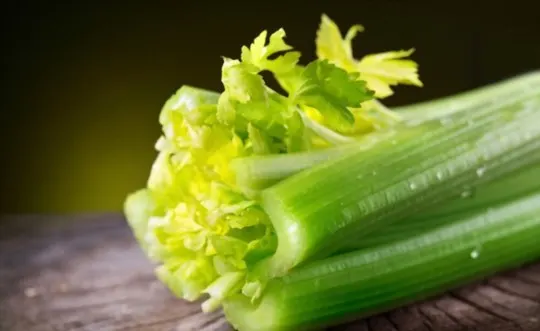
Celery is a vegetable that belongs to the same plant family as carrots, parsley, and fennel.
It is low in calories, high in fiber, and packed with vitamins and minerals.
But, what does celery really taste like?
It is frequently used as a seasoning or garnish, thanks to its unique taste and texture.
It can also be used in soups, stews, salads, and smoothies to add a refreshing and healthy crunch.
Celery is known for its health benefits, including reducing inflammation, lowering blood pressure, and aiding in digestion.
Its high water content and low calorie count make it a popular vegetable for those on a diet or trying to manage their weight.
In short, celery tastes mildly sweet, slightly bitter, and refreshing with a crispy texture.
It is an excellent vegetable to incorporate into a healthy diet or use as a garnish for added flavor and crunch.
What Does Celery Taste Like?
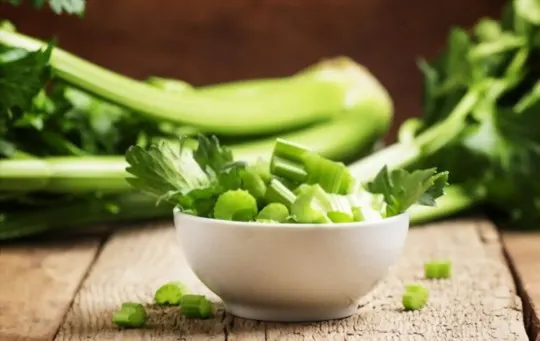
Celery is a crunchy, watery vegetable with a mildly bitter and herbaceous taste profile.
Here’s what celery tastes like:
- Stalks: Celery stalks are crunchy and slightly fibrous with a mild yet distinct vegetal flavor.
- Leaves: Celery leaves are more pungent and bitter than the stalks, with a hint of grassiness.
- Roots: Celery roots have a milder version of the stem’s flavor, with earthy and sweet undertones.
- Hearts: Celery hearts are the tender, light-colored innermost stalks of the plant. They are sweeter and milder than outer stalks.
To enhance the flavor of celery, use it as a base for soups, stews, and sauces or pair it with bold and savory flavors like blue cheese, bacon, and olives.
Factors that Affect the Taste of Celery

Celery has a unique taste that is both savory and slightly bitter.
However, several factors can affect the taste of celery, which can alter its flavor profile.
Here are some of the factors that affect the taste of celery:
- Variety: There are many cultivars of celery, each with a slightly different taste. Golden and white celery, for example, are sweeter and milder than traditional green celery.
- Growing conditions: Soil quality, temperature, and moisture levels can all impact the flavor of celery. Celery grown in poor soil may taste bitter, while celery grown in ideal conditions is sweet and crisp.
- Age: As celery ages, it becomes more bitter and less crisp. That’s why it’s essential to use fresh celery in your dishes.
- Harvesting: Celery harvested early has a milder flavor, while celery harvested later in the season is more bitter.
- Storage: Celery stored for too long can develop a rubbery texture and a more intense flavor.
By considering the factors mentioned above, you can choose and grow celery that suits your desired taste and optimize the conditions for a better flavor.
1 – Season
Seasoning plays a vital role in determining the flavor profile of celery.
Celery has a crunchy texture and a mild, slightly bitter taste, making it a versatile vegetable in cooking and seasoning.
Here are some popular seasoning options for celery:
- Salt: Salt enhances the natural flavors of celery and reduces bitterness.
- Lemon juice: Lemon juice adds brightness to the vegetable’s flavor and can also mask bitterness.
- Olive oil: Olive oil adds a rich flavor to celery and helps distribute seasoning evenly.
- Chili flakes: Chili flakes give celery a spicy kick and can help balance out bitterness.
- Garlic: Garlic adds depth to celery’s flavor profile and can also help mask bitterness.
Celery is a great addition to salads, soups, stews, and stir-fries.
It can also be a healthy snack when paired with hummus or other dips.
Experiment with different seasoning options to find your favorite way to enjoy celery.
2 – Growing Conditions
Growing celery in optimal conditions is essential to achieve the desired flavor profile.
Celery simply tastes like a milder, crunchy version of the stalks we all love but the growing conditions can make a lot of difference.
Here are the ideal conditions for growing celery:
- Climate – Celery prefers cool temperatures between 60-70°F, and mild winters without a hard freeze.
- Soil – Celery grows best in fertile, well-drained soil that is high in organic matter content.
- Sunlight – Celery requires partial shade or filtered sunlight, especially during the hottest part of the day.
- Water – Celery plants need to be kept consistently moist, but not waterlogged. You can use a soaker hose for regular watering.
- Nutrients – Celery plants require regular fertilization to produce healthy foliage and sturdy stalks. You can use a slow-release fertilizer or organic compost.
With the right growing conditions, celery can reach its maximum flavor potential and provide a subtle, refreshing taste that is perfect for salads, soups, and other dishes.
3 – Preparation Method
Celery is a versatile vegetable that can be consumed raw or cooked, making it a great addition to many dishes.
Here are some popular preparation methods and the taste you can expect:
- Raw: When eaten raw, celery has a crisp texture and a mild, refreshing taste, with subtle hints of bitterness and saltiness. It is a popular choice for salads, side dishes, and snacks.
- Cooked: Celery can be cooked in a variety of ways, including sautéed, roasted, and stewed. When cooked, celery loses most of its texture and has a softer and milder taste. It is commonly used in soups, stews, casseroles, and stir-fries to add flavor and nutrition.
- Juiced: Celery juice is a popular health drink that is said to have numerous health benefits, such as promoting weight loss and reducing inflammation. It has a very mild taste, with a slightly sweet and salty flavor.
- Pickled: Pickled celery is another way to enjoy this vegetable. It has a tangy and sour taste with a crunchy texture, making it a great addition to sandwiches, burgers, and salads.
Is Celery Healthy?
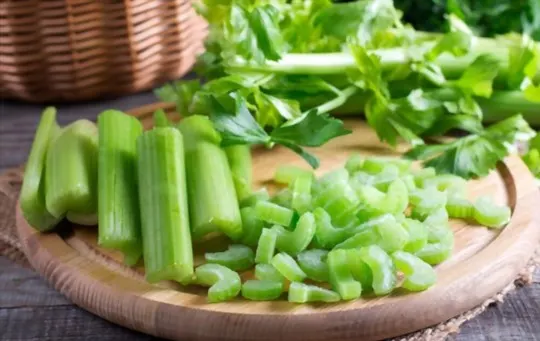
Are you curious about the health benefits of celery? Questions surrounding this low-calorie vegetable are perplexing – but understanding its nutritional impact is essential for a balanced diet.
Celery is jam-packed with vitamins K and C, folate, potassium, and magnesium – all of which promote good health.
There’s evidence that suggests eating celery can improve immunity and reduce inflammation, while its dietary fiber content helps lower cholesterol levels and maintain healthy digestion.
The unique antioxidants in celery keep you feeling energized and ward off disease.
While it’s not a major source of protein, one cup provides just enough to satiate appetites without embarrassing amounts of calories.
With so many nutrients in one crunchy vegetable, it’s no wonder why adding celery to your diet is a great way to stay healthy.
Ways to Use Celery in Cooking
Celery is a versatile vegetable that can add depth and flavor to a wide range of dishes.
Here are some different ways to use celery in cooking:
- As a flavor base: Chopped celery, along with onions and carrots, forms the classic base for many soups, stews, and sauces.
- In salads: Celery adds a crunchy texture to salads and can balance out rich or heavy dressings.
- As a snack: Serve celery sticks with hummus, peanut butter, or cheese for a healthy snack.
- In stir-fries: Sliced celery can add crunch and freshness to stir-fried dishes.
- In juices and smoothies: Celery juice has become a popular drink for its potential health benefits. It has a mild, slightly sweet taste that pairs well with other fruits and vegetables.
Use fresh celery to get the most flavor and nutrients out of this versatile vegetable.
Store it in the refrigerator in a plastic bag or airtight container to keep it fresh for up to two weeks.
How Do You Make Celery Taste Good?
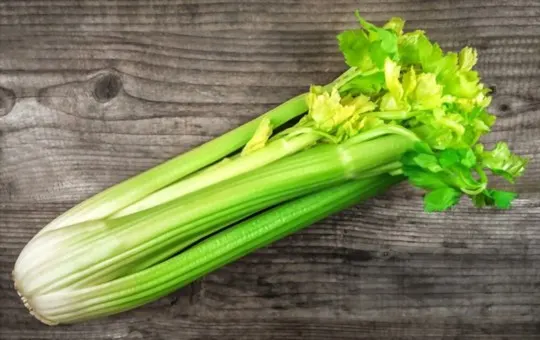
Celery is often considered a bland and uninteresting vegetable, but there are many ways to make it taste delicious, and even those who dislike its natural flavor can learn to appreciate it.
Here are some tips to make celery taste good:
- Pair it with flavorful dips: Enjoy celery with yummy dips like peanut butter, hummus, ranch, or tzatziki to add flavor to your snack or appetizer.
- Cook it with other ingredients: Add celery to soups, stews or stir-fries with other flavorful ingredients like onions, garlic, tomato or beef for a tasty and aromatic dish that masks the celery’s natural taste.
- Roast or grill it: Roasting or grilling celery is a great way to bring out its natural sweetness and add a smoky flavor. Drizzle it with olive oil and toss with salt and black pepper before roasting at 375°F (190°C) for 15-20 minutes.
- Juice it: Celery juice is a popular wellness trend that combines celery with other ingredients like cucumber, lemon, and ginger. It is refreshing, nutritious, and flavorful – a great way to enjoy celery’s health benefits without munching on raw stalks.
Conclusion
To conclude, celery has a unique flavor profile that can be described as crispy, refreshing, and mildly bitter.
Its taste is often compared to that of parsley or fennel, with a subtle sweetness and a slight saltiness.
Celery’s flavor intensifies when cooked, making it an excellent ingredient for stews, soups, and casseroles.
It’s also a versatile vegetable that can be eaten raw as a snack or added to salads for extra crunch.
Celery is also rich in nutrients, including fiber, vitamins, and minerals, making it a healthy addition to any diet.
So, whether you love or hate the taste of celery, there’s no denying its health benefits and culinary versatility.
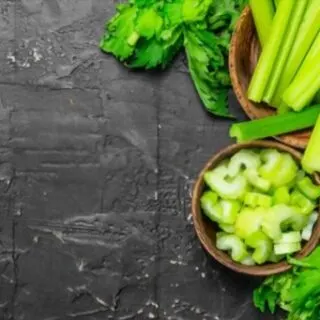
What Does Celery Taste Like? A Comprehensive Guide
Ingredients
- Celery
- Ingredients from your selected recipes
Instructions
- Select your favorite ingredient from the range available in this article.
- Collect all the necessary items to make the recipe.
- Use the instructions provided to prepare a delicious dish in 30 minutes or less.

Carrie is a food writer and editor with more than 15 years of experience. She has worked for some of the biggest names in the food industry, including Bon Appétit, Food & Wine, and Martha Stewart Living.
As the Editor in Chief of IntroChicago.com, Carrie oversees all of the content on the site. She also manages the team of contributing writers and editors, who help to create delicious recipes, helpful tips, and informative articles that you’ll find on the site.
A native of the Chicago area, Carrie is passionate about all things food. She loves trying new restaurants and experimenting with new recipes in her kitchen. She’s also a graduate of the Culinary Institute of America, so she knows a thing or two about food!
